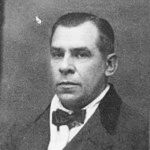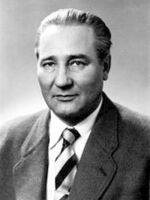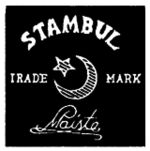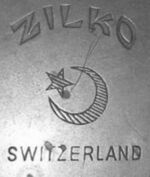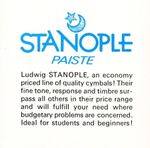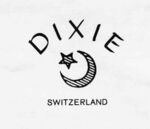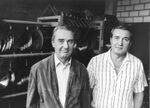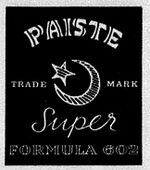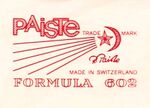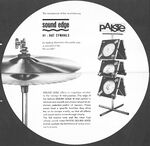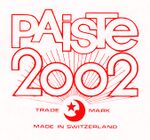12"
Paiste production history time
Contents
- 1 Paiste production history time
- 2 1901-1916: Russia
- 3 1917-1939: Estonia
- 4 1932: STAMBUL series
- 5 1935: ZILKO series
- 6 1945: German production facility
- 7 1949: CHINA CYMBAL
- 8 1950: STANOPLE series
- 9 1954: DIXIE series
- 10 1955: SUPER series
- 11 1957: Swiss production facility
- 12 1957: "Ludwig", "Ludwig Standard" series, Sales/distribution in the U.S.
- 13 1957: SUPER FORMULA 602
- 14 1959: FORMULA 602
- 15 1963: CuSn8 "B8" bronze is born
- 16 1963: CHINA CYMBAL with round bell
- 17 1965: STAMBUL65
- 18 1967: GIANT BEAT
- 19 1967/1968
- 20 1971: 2oo2
- 21 1974" 4o4/5o5 series
- 22 1980: Invention of un-lathed cymbals: RUDE
- 23 1981: North American distribution center (greater Los Angeles area)
1901-1916: Russia
Michail Toomas PAISTE, composer and musician founded a sheet music publishing house and music shop in Saint Petersburg in 1901, which also made simple instruments and carried out repairs.
His father was from Estonia and was a member of the Tsar's Guard. The business flourished very well for many years until the Russian Revolution forced it to close.
1917-1939: Estonia
Mikhail Toomas returned to his homeland and opened a new shop in Tallinn, the capital of Estonia.
This is also where the first cymbals for concert and brass music were designed and manufactured. The demand for PAISTE products increased.
In 1930, at the same time as the new trends in music, his son, Michail M. began making cymbals.
Michail M. chose the Turkish form of production and developed his own concept with which he gave the PAISTE cymbals a new sound direction. He quickly became the driving force behind the still small company and eventually took over the business.
In addition, Michail M.PAISTE also developed the first PAISTE gongs that came into the market. His award-winning products, both the cymbals and gongs, soon had a very good international reputation, so he began exporting to Europe and the USA.
In 1945 Michail M. and his family fled Poland and settled in northern Germany near Rendsburg. Michail M. began to build up a cymbal and gong production for the third time. At the beginning of the 50s he was able to reactivate the old business relationships and the export business began to flourish again.
The relocation of production to Burg (Dithmarschen) failed, and finally, in 1957, Michail M. founded a manufacture in Switzerland.
1932: STAMBUL series
The STAMBUL comes onto the market in 1932 (produced in Estonia from 1932 to 1941, Germany from 1948 to 1957 and then Switzerland from 1957 to 1964) It's made of nickel silver "NS12" until approximately 1964 or as late as 1970. It was then produced from CuSn8 "B8" bronze until phase out and transition in to the 505 series in 1978.
The STAMBUL is an absolute upper class cymbal for the era up to the Second World War and the quality of these PAISTE cymbals speaks for itself.
1935: ZILKO series
PAISTE needs a beginner's cymbal: In 1935 PAISTE launched the lower-priced ZILKO series, making it the first cymbal manufacturer in the world to offer more than one cymbal level of quality.
These new cymbals are made in Estonia from special brass MS63 (1935-1953), then in Germany from nickel silver "NS12" (1953-1960) as ZILKO STANDARD.
It is possible the line was discontinued in the 50s and then they revived the Zilko (and Zilket) name in the 60s for sales through Arbiter.
This would seem to make sense since the Zilko name doesn't seem to appear in any of the 60s Paiste catalogs.
1945: German production facility
Today all PAISTE gongs and budget cymbal series (from ALPHA down to the 101 BRASS series) labeled: "Made in Germany" are manufactured in Schacht-Audorf near Rendsburg by approx. 30 employees.
1949: CHINA CYMBAL
PAISTE is the first company in the world to integrate Chinese cymbals into the setup of drummers for modern music.
1950: STANOPLE series
PAISTE brings the STANOPLE series onto the market in 1950 (The 2009 Paiste timeline gives the start date as 1950, but the line isn't listed in any of the 1950s era catalogs we have in our possession.).
These cymbals are initially made in Germany, later in the new Swiss production facility.
All evidence points to them being made from "NS12" until possibly the last couple years of production, there is evidence that some late model Stanoples were made from CuSn8 "B8" bronze.
The stamp contains under the crescent moon with a star "STANOPLE, Made in Germany, PAISTE" or "STANOPLE, Made in Switzerland, PAISTE".
They are mainly offered in the USA, from 1959 through the distributor Ludwig Drum Company Chicago.
We don't know exactly how long they were produced, but STANOPLE cymbals can be found listed in the Ludwig catalog until 1973.
1954: DIXIE series
The DIXIE series is a new entry-level series and the possible successor to the ZILKO series. DIXIE's are made of nickel silver "NS12", allegedly there are also some made of brass MS63 (CuZn37).
The die does not contain the word “PAISTE”, only “DIXIE” and the crescent moon with a star. Including either “Made in Germany” or just “Switzerland”.
From 1971 DIXIEs are also available with a black print and were produced from CuSn8 "B8" bronze until phase out and transition in to the 404 series in 1978.
1955: SUPER series
PAISTE brings a new line of cymbals onto the market in 1955 with the name SUPER.
These new cymbals are a little thinner and are again made of nickel silver "NS12" until 1962, initially only in Germany.
The name “PAISTE” is not found in the die, but to the left of the crescent moon including the star only the word “SUPER”, including “Made in Germany” or later also “SUPER”, including “Switzerland”.
1957: Swiss production facility
In 1957 Michail M. founded a new production workshop in Switzerland with his two sons Robert and Toomas (the 3rd generation).
A new era began under the direction of Robert (* 1932) and Toomas (* 1939) and Nottwil, located on Lake Sempach in the canton of Lucerne, developed into the center of all international activities.
In 1970, a new factory was built next to the existing one. In 1995 Toomas took over the role of President from Robert.
Since 2003, the company is headed by Toomas’ son, Erik.
1957: "Ludwig", "Ludwig Standard" series, Sales/distribution in the U.S.
With its new production facility in Switzerland, PAISTE intends to eliminate trade restrictions and enter international markets: The Ludwig Drum Company becomes the distributor for the US market.
This can be described as a great business success for PAISTE: Ludwig had sold only Zildjian cymbals from their first catalog starting in 1912.
From 1957: a less expensive PAISTE series is offered in addition to the higher-quality Zildjian, under the name "Ludwig".
Ludwig cymbals are first made in Germany (still with the addition CHICAGO on the stamp), then later in Switzerland, all are made of nickel silver.
A little later, Ludwig STANDARD (with the new Ludwig STANDARD logo) were added to the catalog and these can be classified as an upscale entry-level line (see Ludwig Book by Rob Cook, among others).
Ludwig STANDARD cymbals are initially made in Switzerland and then from 1960 onwards in Germany; they are also made of nickel silver.
Below that price you will find the STANOPLE series, which replaced the first LUDWIG basins in the catalogs from 1960.
1957: SUPER FORMULA 602
PAISTE has been experimenting with cymbals made of B20 bell bronze for a long time.
In 1957 the first came onto the market under the name SUPER FORMULA 602, the stamp of this series still looks very similar to the STAMBUL stamp.
Above with the curved PAISTE lettering (even the letter shape is the same), below TRADE MARK including half moon with star, below SUPER in cursive cursive, below FORMULA 602, and finally SWISS MADE, a name that was only used in the initial phase in Nottwil was used before the switch to MADE IN SWITZERLAND.
Later stamps look almost like the FORMULA 602 stamp, ie with the rectangular PAISTE font and the seven rays of the sun to the left of the star, on the right below the signature of Robert PAISTE, and below it MADE IN SWITZERLAND. However, the term FORMULA 602 does not appear in this stamp. The cheaper SUPER series must not be confused with the SUPER FORMULA 602.
These basins are also thinner, but the dies look completely different. The cymbals of the SUPER series are not made of the expensive B20 alloy, but of the German silver NS12, which is half cheaper, or later of B8. Even if the rumor persists, it
1959: FORMULA 602
After two years of experimenting with B20 Bronze, the FORMULA 602 series saw the light of day in the cymbal world in 1959.
These traditional bronze cymbals are almost twice as expensive as the STAMBULs, but they are also something very special, especially in terms of sound, they overshadow everything that Paiste had previously produced.
Their sound character is defined as fine and clear, transparent, but still full of not too many overtones. The FORMULA 602 series, which has its roots in jazz and acoustic rock'n'roll, gave PAISTE the first big wave of international fame.
1963: CuSn8 "B8" bronze is born
In 1963 PAISTE began to experiment with CuSn8, a bronze alloy with a high copper content (92% copper and 8% tin), also called B8.
In the 1970s, this somewhat more reddish alloy became world-famous as "2oo2 bronze". B8 is more elastic than the traditional bell bronze B20, it is also easier to work (roll, hammer, turn) than B20.
The old production machines can still be used, which is an advantage. Other reasons for the change were, in addition to rising bell bronze and nickel prices, B8 has a sonic quality that is perfect for cutting through loud amplified music!
1963: CHINA CYMBAL with round bell
For the first time in 1963 the “Turkish bell” is used in a China cymbal, again a PAISTE innovation.
1965: STAMBUL65
PAISTE's second B8 cymbal comes onto the market, the STAMBUL65 series. This will be produced until around 1971 (also in stock), but they will be sold for longer, the remaining stock quantities will then be relabeled to 505. In general, PAISTE now also offers printed labels as additional identification to the embossing stamp. PAISTE cymbals are now known for their consistent quality and this B8 series fits seamlessly into this picture. I am also the proud owner of a STAMBUL65 Ride Cymbal. The sound of the STAMBUL65 comes very close to the first 2oo2, so you have to listen carefully. It is interesting that my STAMBUL65 Ride from 1973 with 1970 grams is much lighter than my 2oo2 Ride from 1972, which weighs 2375g.
1967: GIANT BEAT
1967/1968
Invention of the wavy edge hi-hat bottom cymbal - Sound Edge hi-hats
Invention of the bell-less flat ride cymbal (originally called the "space sound")
1971: 2oo2
1974" 4o4/5o5 series
1980: Invention of un-lathed cymbals: RUDE
===1981: all series, end of the Black Label era===
1981: North American distribution center (greater Los Angeles area)
In 1981, PAISTE gained a foothold in the world's largest music market with the founding of PAISTE America, Inc. in Brea, California.
Toomas lived in the USA for some time in the 80s and was instrumental in founding and developing the sales/distribution branch.
In August 2002 Toomas had a fatal accident in Spain, his son Erik (the 4th generation) took over all his functions.
Today Nottwil is the headquarters of PAISTE AG and supplies the whole world with high-quality, mostly hand-made basins "Made in Switzerland" from the 2oo2 to the SIGNATURE series. PAISTE is the largest manufacturer of musical instruments in Switzerland.
Information from the Paiste.com site[1]
Return to the Paiste Series Portal
Return to the Paiste Cymbal Type Portal
